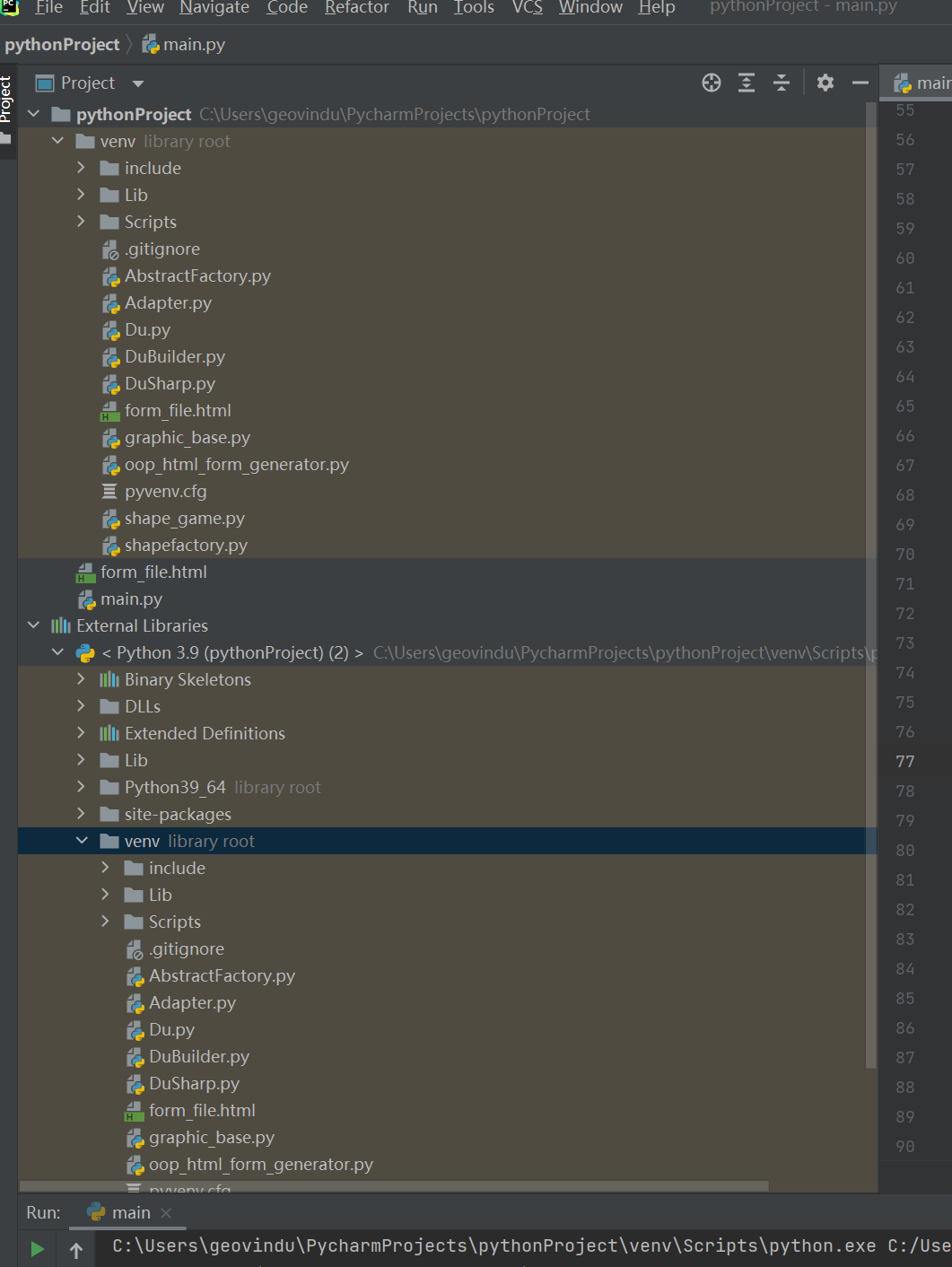Python: Builder Pattern
DuBuilder.py
1 2 3 4 5 6 7 8 9 10 11 12 13 14 15 16 17 18 19 20 21 22 23 24 25 26 27 28 29 30 31 32 33 34 35 36 37 38 39 40 41 42 43 44 45 46 47 48 49 50 51 52 53 54 55 56 57 58 59 60 61 62 63 64 65 66 67 68 69 70 71 72 73 74 75 76 77 78 79 80 81 82 83 84 85 86 87 88 89 90 91 92 93 94 95 96 97 98 99 100 101 102 103 104 105 106 107 108 109 110 111 112 113 114 115 116 117 118 119 120 121 122 123 124 125 126 127 128 129 130 131 132 133 | # 生成器模式 Builder Patternfrom __future__ import annotationsfrom abc import ABC, abstractmethodfrom typing import Anyclass Builder(ABC): """ The Builder interface specifies methods for creating the different parts of the Product objects. """ @property @abstractmethod def product(self) -> None: pass @abstractmethod def produce_part_a(self) -> None: pass @abstractmethod def produce_part_b(self) -> None: pass @abstractmethod def produce_part_c(self) -> None: passclass ConcreteBuilder1(Builder): """ The Concrete Builder classes follow the Builder interface and provide specific implementations of the building steps. Your program may have several variations of Builders, implemented differently. """ def __init__(self) -> None: """ A fresh builder instance should contain a blank product object, which is used in further assembly. """ self.reset() def reset(self) -> None: self._product = Product1() @property def product(self) -> Product1: """ Concrete Builders are supposed to provide their own methods for retrieving results. That's because various types of builders may create entirely different products that don't follow the same interface. Therefore, such methods cannot be declared in the base Builder interface (at least in a statically typed programming language). Usually, after returning the end result to the client, a builder instance is expected to be ready to start producing another product. That's why it's a usual practice to call the reset method at the end of the `getProduct` method body. However, this behavior is not mandatory, and you can make your builders wait for an explicit reset call from the client code before disposing of the previous result. """ product = self._product self.reset() return product def produce_part_a(self) -> None: self._product.add("发动机") def produce_part_b(self) -> None: self._product.add("车架") def produce_part_c(self) -> None: self._product.add("车身")class Product1(): """ It makes sense to use the Builder pattern only when your products are quite complex and require extensive configuration. Unlike in other creational patterns, different concrete builders can produce unrelated products. In other words, results of various builders may not always follow the same interface. """ def __init__(self) -> None: self.parts = [] def add(self, part: Any) -> None: self.parts.append(part) def list_parts(self) -> None: print(f"产品部分为: {', '.join(self.parts)}", end="")class Director: """ The Director is only responsible for executing the building steps in a particular sequence. It is helpful when producing products according to a specific order or configuration. Strictly speaking, the Director class is optional, since the client can control builders directly. """ def __init__(self) -> None: self._builder = None @property def builder(self) -> Builder: return self._builder @builder.setter def builder(self, builder: Builder) -> None: """ The Director works with any builder instance that the client code passes to it. This way, the client code may alter the final type of the newly assembled product. """ self._builder = builder """ The Director can construct several product variations using the same building steps. """ def build_minimal_viable_product(self) -> None: self.builder.produce_part_a() def build_full_featured_product(self) -> None: self.builder.produce_part_a() self.builder.produce_part_b() self.builder.produce_part_c() |
main.py
调用:
1 2 3 4 5 6 7 8 9 10 11 12 13 14 15 16 17 18 19 20 21 22 23 24 | ## 生成器模式 Builder Pattern director = DuBuilder.Director() builder = DuBuilder.ConcreteBuilder1() director.builder = builder print("\n") print("生成器模式 Builder Pattern") print("产品最基本的部分: ") director.build_minimal_viable_product() builder.product.list_parts() print("\n") print("标准的全功能产品: ") director.build_full_featured_product() builder.product.list_parts() print("\n") # Remember, the Builder pattern can be used without a Director class. print("客户需要的产品部分: ") builder.produce_part_a() builder.produce_part_b() builder.product.list_parts() |
输出:
1 2 3 4 5 6 7 8 9 10 | 生成器模式 Builder Pattern产品最基本的部分: 产品部分为: 发动机标准的全功能产品: 产品部分为: 发动机, 车架, 车身客户需要的产品部分: 产品部分为: 发动机, 车架Process finished with exit code 0 |

哲学管理(学)人生, 文学艺术生活, 自动(计算机学)物理(学)工作, 生物(学)化学逆境, 历史(学)测绘(学)时间, 经济(学)数学金钱(理财), 心理(学)医学情绪, 诗词美容情感, 美学建筑(学)家园, 解构建构(分析)整合学习, 智商情商(IQ、EQ)运筹(学)生存.---Geovin Du(涂聚文)
分类:
Python




【推荐】国内首个AI IDE,深度理解中文开发场景,立即下载体验Trae
【推荐】编程新体验,更懂你的AI,立即体验豆包MarsCode编程助手
【推荐】抖音旗下AI助手豆包,你的智能百科全书,全免费不限次数
【推荐】轻量又高性能的 SSH 工具 IShell:AI 加持,快人一步
· 25岁的心里话
· 闲置电脑爆改个人服务器(超详细) #公网映射 #Vmware虚拟网络编辑器
· 基于 Docker 搭建 FRP 内网穿透开源项目(很简单哒)
· 零经验选手,Compose 一天开发一款小游戏!
· 一起来玩mcp_server_sqlite,让AI帮你做增删改查!!
2011-10-19 Csharp windowform controls clear